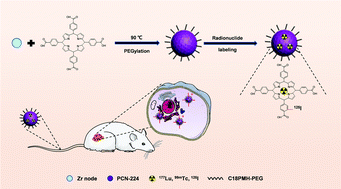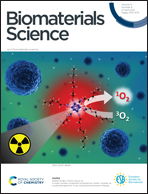Versatile labeling of multiple radionuclides onto a nanoscale metal–organic framework for tumor imaging and radioisotope therapy†
Abstract
Radionuclides for cancer theranostic have confronted problems such as limitation in real-time visualization and unsatisfactory therapeutic effect sacrificed by the nonspecific distribution. Nanoscale metal–organic frameworks (nMOFs) have been widely used in biomedical applications including cancer imaging and drug delivery. However, there have been rare reports utilizing nMOFs as a single nanoplatform to label various radionuclides for tumor imaging and radioisotope therapy (RIT). In this work, we developed polyethylene glycol (PEG) modified zirconium-based nMOFs (PCN-224) with favorable size, water solubility and biocompatibility. Interestingly, without the help of chelating agents, metal radionuclides (technetium-99 m/99mTc, lutetium-177/177Lu) could be efficiently labeled onto nMOFs via chelating with the porphyrin structure and iodine-125 (125I) via chemical substitution of hydrogen in the benzene ring. The radionuclide-labeled PCN-PEG nanoparticles all exhibit excellent radiolabeling stability in different solutions. In accordance with the fluorescence imaging of mice injected with PCN-PEG, SPECT/CT imaging illustrates strong tumor accumulation of 99mTc-PCN-PEG. Moreover, 177Lu-PCN-PEG significantly inhibited the growth of tumor without inducing any perceptible toxicity to the treated mice. Hence, the radionuclide-delivery nanoplatform based on nMOFs would provide more opportunities for precise tumor theranostics and expand the biomedical applications of MOF nanomaterials.



 Please wait while we load your content...
Please wait while we load your content...